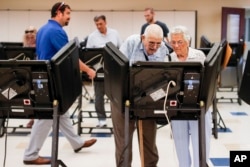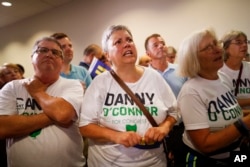A special congressional election that tested President Donald Trump's clout and cost both parties millions of dollars in battleground Ohio was too close to call early Wednesday. Trump claimed victory nevertheless.
The president took credit for Republican Troy Balderson's performance, calling it "a great victory,'' even though the contest could be headed to a mandatory recount. Democrat Danny O'Connor, trailing in the latest count, vowed: "We're not stopping now.''
The candidates were locked in a razor-thin race, which they will reprise in the general election in just three months. There were at least 3,367 provisional ballots left to be reviewed. That's enough for O'Connor to potentially pick up enough to force a recount.
The Associated Press does not declare winners in races subject to an automatic recount.
The Republican president's shadow also loomed over primary contests in four other states, none bigger than Kansas, where Trump roiled the governor's race by opposing the GOP incumbent on the eve of the election.
The day's races, like dozens before them, pitted Trump's fiery supporters against the Democratic Party's anti-Trump resistance. The results are helping determine the political landscape - and Trump's standing within his own party - just before the GOP defends its House and Senate majorities in November.
Voters in Kansas, Missouri, Michigan and Washington state joined those in Ohio in Tuesday's voting.
Kansas Republicans were fighting among themselves in a battle for governor, where Secretary of State Kris Kobach was trying to unseat Gov. Jeff Colyer.
Should the polarizing Kobach win the primary, some Republican operatives fear he could lose the governor's seat to Democrats this fall. The race could become further disrupted if Kansas City-area businessman Greg Orman makes it onto the November ballot. He submitted petitions Monday with more than 10,000 signatures for what could become the most serious independent run for Kansas governor in decades.
Trump made his preference clear for Kobach.
"He is a fantastic guy who loves his State and our Country - he will be a GREAT Governor and has my full & total Endorsement! Strong on Crime, Border & Military,'' the president tweeted on the eve of the election. "VOTE TUESDAY!''
Republicans were hoping for Democratic discord in Kansas' 3rd Congressional District, a suburban Kansas City district where several candidates were fighting for the chance to take on Republican Rep. Kevin Yoder in November.
The five-way Democratic primary featured labor lawyer Brent Welder, who campaigned recently with self-described democratic socialists Vermont Sen. Bernie Sanders and ascending political star, Alexandria Ocasio-Cortez, a New York congressional candidate.
Also in the race: Native American attorney Sharice Davids and former school teacher Tom Niermann.
In Ohio, the script for the special election was somewhat familiar: An experienced Trump loyalist, Balderson, was fighting a strong challenge from O'Connor, a fresh-faced Democrat, in a congressional district held by the Republican Party for more than three decades. In an election morning tweet, Trump said Balderson would make a "great congressman.''
The winner takes the seat previously held by Pat Tiberi, a nine-term incumbent who resigned to take a job with an Ohio business group.
In a special election season that featured nearly a dozen congressional races, Democrats claimed just a handful of wins, but they may have cause for optimism this fall. In virtually every special election test dating back to the spring of 2017, Democratic candidates performed significantly better than their party in those same places two years earlier.
Trump won Ohio's 12th Congressional District, for example, by more than 11 points in 2016; on Tuesday night, Balderson and O'Connor were separated by less than 1 point.
There are 79 House races this fall considered more competitive than the Ohio district - at least looking at Trump's 2016 performance - according to data compiled by the Democrats' national campaign committee.
Despite the deadlocked race, the specific Ohio returns suggest considerably higher Democratic enthusiasm less than 100 days before the midterms.
O'Connor's total of nearly 100,000 votes far exceeded what the district's former Republican congressman Pat Tiberi's Democratic opponent got in 2014. Balderson's total - just more than 101,500 votes - is barely two-thirds of Tiberi's 2014 mark of about 150,000.
The two will face off again in November to see who holds the seat in 2019 and 2020.
"Over the next three months, I'm going to do everything I can to keep America great again, so that when we come back here in November - get ready, we gotta come back here in November - I have earned your vote for a second time,'' Balderson told supporters.
It's unclear how much Trump's support helped or hurt Balderson. Described by campaign operatives as a "Whole Foods'' district, the largely suburban region features a more affluent and educated voter base than the typical Trump stronghold.
Ohio Gov. John Kasich, a leading voice in the GOP's shrinking anti-Trump wing, once represented the district in Congress.
At times, the race centered on Trump's tax cuts as much as the candidates.
O'Connor and his Democratic allies railed against the tax plan, casting it as a giveaway for the rich that exacerbates federal deficits and threatens Medicare and Social Security. Balderson and his Republican allies have backed away from the tax plan in recent weeks, training their fire instead on top House Democrat Nancy Pelosi.
O'Connor dominated Balderson on the local airwaves. His campaign spent $2.25 million on advertising compared to Balderson's $507,000, according to campaign tallies of ad spending. The Republican campaign arm and its allied super PAC were forced to pick up the slack, spending more than $4 million between them.
In Michigan, three mainstream Democrats in suburban Detroit were among those vying for a chance at retiring Republican Rep. Dave Trott's seat in November. The field included Fayrouz Saad, who would be the first Muslim woman in Congress.
And in suburban Seattle, three Democrats vied in a jungle primary for the seat held by another retiring Republican, Rep. Dave Reichert.
The field was set in two Senate contests as well.
In Missouri, Democratic Sen. Claire McCaskill claimed her party's nomination, while state Attorney General Josh Hawley will represent the GOP.
And in Michigan, Democratic Sen. Debbie Stabenow will take on military veteran and business executive John James, who won the Republican nomination. He would join Tim Scott of South Carolina as the only black Republican senators if he wins in November.
Hours before polls opened, Trump again weighed in on Twitter, casting James as "a potential Republican star.''




























